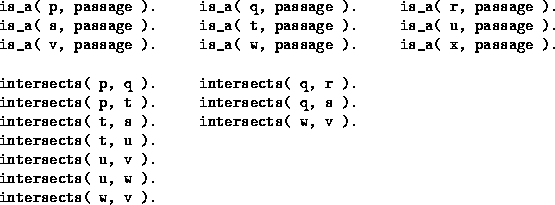
The caves world offers a particularly clear example of alternative
representations. It was set up using atoms such as a and b to name
caves. We used the predicate meets to indicate that two caves were
directly connected, so meets(a,b) meant that a was linked to b,
with no other caves in between.
In an alternative representation, instead of naming caves, we can name passages. I have done this in the listing below.

Here, p names a passage - a path that has a cave at each end, but
not anywhere else along it. intersects(p,q) means that one end of
passage p meets one end of passage q, and that there is a cave
there. By drawing a complete map, you can satisfy yourself that these
facts describe the same world as that introduced in Supplement 2.
How would you extend this style of representation to describe the location of the cave-world's inhabitants? What are its advantages or disadvantages?